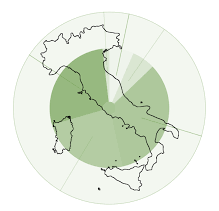News
Italian GBD Initiative: an analysis of the impact of diseases and risk factors in Italy
On Tuesday, April 8, 2025, from 2:30 p.m. to 5:30 p.m., as part of the pre-convention activities of the AIE congress (XLIX - Congress of the Italian Association of Epidemiology 2025 | AIE - Italian Association of Epidemiology), the Grand Hotel Salerno will host the event "Italian GBD Initiative: analysis, contributions and hybridizations within the Global Burden of Disease Project." The meeting will bring together Italian experts to discuss the latest Global Burden of Disease (GBD) estimates...
The global burden of diarrheal diseases: a comprehensive analysis of causes, risks, and solutions
Diarrheal diseases continue to be a global health emergency, especially in low- and middle-income countries. Despite progress in reducing child mortality, the impact of diarrheal infections remains significant. According to 2021 data, these diseases caused 1.51 million deaths worldwide, including 650,000 among children under five. This article takes an in-depth look at the causes, risk factors, consequences, and possible solutions to address this health crisis. A global picture: size and...
Health inequalities in the United States: the “Ten Americas” and the alarming gap in life expectancy
Over the past two decades, differences in health and life expectancy in the United States have become increasingly pronounced. These inequalities, often related to place of residence, economic conditions, and racial and ethnic identity, have reached alarming levels. A study published in the prestigious journal The Lancet found that these differences have divided the country into ten mutually exclusive populations, referred to by the authors as "The Ten Americas." This classification is an...
Inequalities in Welfare and the Opportunities for the Future.
Combating social and geographic inequalities is among the most urgent and complex challenges facing contemporary society. Inequalities in well-being affect not only the distribution of resources, but also access to opportunities that can ensure a long, healthy and fulfilling life. A recent study of the United States, conducted by the IHME as part of the GBD Project, highlighted deep disparities among racially, ethnically, and geographically distinct groups, raising important public policy...
Lifeless births: an invisible tragedy the world cannot ignore
The phenomenon of stillbirth, or birth without life, represents one of the most profound and least visible tragedies in global health. Every year, millions of families face the pain of losing a child in the womb, an event that affects them personally, familially and socially, but receives surprisingly little attention. The global data are telling: in 2021, 3.03 million stillbirths occurred, equivalent to about one every ten seconds. This problem affects not only low- and middle-income...
Disability reform and health: an analysis of differences in disability weights for back pain
Back pain is a major cause of disability globally, significantly affecting the daily lives of people who suffer from it. According to data from a systematic review, back pain is responsible for a high number of doctor visits and absences from work. Despite its prevalence, the assessment of disability caused by this condition is not uniform, varying by geographic region, treatment modalities and local health care systems. This studio, posted at The Lancet Rheumatology by a group of Global...
Resilient communities: the impact of local food programs in combating food insecurity
On a sunny day in Clearwater, Florida, more than a dozen people gathered in a United Way resource center parking lot, eager to receive free weekly meals offered by the 360 Eats food truck. This truck cooks dishes from food that would otherwise go to waste. That day, attendees could choose from a bowl of chicken with fresh vegetables, pasta salad, and a creamy sauce, or a fish stew with vegetables, creamy granola, and an herb sauce. Among those present, a woman in uniform, fresh from her shift...
Lung cancer and smoking in Tuscany: results of the ACAB study
In 2022 in Tuscany, lung cancer caused 195 and 541 years of life lived with disability (YLD) in women and men, respectively, corresponding to about 9 and 25 YLD per 100,000 people. Of these, about 53% in women and 66% in men were caused by smoking. These data come from the ACAB(Attributable Cancer Burden in Tuscany) study, a project funded by the Region of Tuscany under the 2018 Health Research Call for Proposals conducted by the Institute for the Study and Prevention and Oncology Network...
The future of global health: a perspective on changes in life expectancy and the burden of smoking
Smoking is the leading behavioral risk factor for mortality globally, responsible for more than 175 million deaths and nearly 4.30 billion years of life lost (YLL) from 1990 to 2021. The pace of decline in smoking prevalence has slowed in recent years for many countries, and although strategies to achieve tobacco-free generations have recently been proposed, none have been implemented to date. This is the finding of the recent Global Burden of Disease analysis published in Lancet Public...
Global stroke: the impact of environmental and behavioral factors on a growing crisis
Between 1990 and 2021, globally, the number of people per year who suffered a new stroke increased by 70 percent, deaths caused by stroke increased by 44 percent, and stroke-related health loss, measured in disability-adjusted life years (DALYs), increased by 32 percent. This trend reflects the combined increase in the global population, an aging population, and increased exposure to behavioral and environmental risk factors. Stroke: a preventable but growing disease Despite being highly...
